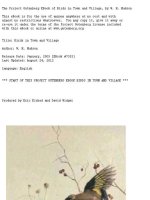The Project Gutenberg EBook of Solid Geometry with Problems and Applications (Revised edition) potx
Bạn đang xem bản rút gọn của tài liệu. Xem và tải ngay bản đầy đủ của tài liệu tại đây (6.48 MB, 242 trang )
The Project Gutenberg EBook of Solid Geometry with Problems and
Applications (Revised edition), by H. E. Slaught and N. J. Lennes
This eBook is for the use of anyone anywhere at no cost and with
almost no restrictions whatsoever. You may copy it, give it away or
re-use it under the terms of the Project Gutenberg License included
with this eBook or online at www.gutenberg.org
Title: Solid Geometry with Problems and Applications (Revised edition)
Author: H. E. Slaught
N. J. Lennes
Release Date: August 26, 2009 [EBook #29807]
Language: English
Character set encoding: ISO-8859-1
*** START OF THIS PROJECT GUTENBERG EBOOK SOLID GEOMETRY ***
Bonaventura Cavalieri (1598–1647) was one of the most influential
mathematicians of his time. He was chiefly noted for his invention of
the so-called “Principle of Indivisibles” by which he derived areas and
volumes. See pages 143 and 214.
SOLID GEOMETRY
WITH
PROBLEMS AND APPLICATIONS
REVISED EDITION
BY
H. E. SLAUGHT, Ph.D., Sc.D.
PROFESSOR OF MATHEMATICS IN THE UNIVERSITY OF CHICAGO
AND
N. J. LENNES, Ph.D.
PROFESSOR OF MATHEMATICS IN THE UNIVERSITY
OF MONTANA
ALLYN and BACON
Bo<on New York Chicago
Produced by Peter Vachuska, Andrew D. Hwang, Chuck Greif
and the Online Distributed Proofreading Team at
transcriber’s note
The original book is copyright, 1919, by H. E. Slaught and N. J.
Lennes.
Figures may have been moved with respect to the surrounding
text. Minor typographical corrections and presentational
changes have been made without comment.
This PDF file is formatted for printing, but may be easily
recompiled for screen viewing. Please see the preamble of the
L
A
T
E
X source file for instructions.
PREFACE
In re-writing the Solid Geometry the authors have consistently car-
ried out the distinctive features described in the preface of the Plane
Geometry. Mention is here made only of certain matters which are
particularly emphasized in the Solid Geometry.
Owing to the greater maturity of the pupils it has been possible
to make the logical structure of the Solid Geometry more prominent
than in the Plane Geometry. The axioms are stated and applied at
the precise points where they are to be used. Theorems are no longer
quoted in the proofs but are only referred to by paragraph numbers;
while with increasing frequency the student is left to his own devices
in supplying the reasons and even in filling in the logical steps of the
argument. For convenience of reference the axioms and theorems of
plane geometry which are used in the Solid Geometry are collected in
the Introduction.
In order to put the essential principles of solid geometry, together
with a reasonable number of applications, within limited bounds (156
pages), certain topics have been placed in an Appendix. This was
done in order to provide a minimum course in convenient form for class
use and not because these topics, Similarity of Solids and Applications
of Projection, are regarded as of minor importance. In fact, some of
the examples under these topics are among the most interesting and
concrete in the text. For example, see pages 180–183, 187–188, 194–
195.
The exercises in the main body of the text are carefully graded as
to difficulty and are not too numerous to be easily performed. The
concepts of three-dimensional space are made clear and vivid by many
simple illustrations and questions under the suggestive headings “Sight
PREFACE
Work.” This plan of giving many and varied simple exercises, so effec-
tive in the Plane Geometry, is still more valuable in the Solid Geometry
where the visualizing of space relations is difficult for many pupils.
The treatment of incommensurables throughout the body of this
text, both Plane and Solid, is believed to be sane and sensible. In each
case, a frank assumption is made as to the existence of the concept in
question (length of a curve, area of a surface, volume of a solid) and of
its realization for all practical purposes by the approximation process.
Then, for theoretical completeness, rigorous proofs of these theorems
are given in Appendix III, where the theory of limits is presented in
far simpler terminology than is found in current text-books and in such
a way as to leave nothing to be unlearned or compromised in later
mathematical work.
Acknowledgment is due to Professor David Eugene Smith for the use
of portraits from his collection of portraits of famous mathematicians.
H. E. SLAUGHT
N. J. LENNES
Chicago and Missoula,
May, 1919.
CONTENTS
INTRODUCTION 1
Space Concepts . . . . . . . . . . . . . . . . . . . . . . . . . . 1
Axioms and Theorems from Plane Geometry . . . . . . . . . . 5
BOOK I. Properties of the Plane 10
Perpendicular Planes and Lines . . . . . . . . . . . . . . . . . 11
Parallel Planes and Lines . . . . . . . . . . . . . . . . . . . . . 21
Dihedral Angles . . . . . . . . . . . . . . . . . . . . . . . . . . 29
Constructions of Planes and Lines . . . . . . . . . . . . . . . . 37
Polyhedral Angles . . . . . . . . . . . . . . . . . . . . . . . . . 42
BOOK II. Regular Polyhedrons 53
Construction of Regular Polyhedrons . . . . . . . . . . . . . . 56
BOOK III. Prisms and Cylinders 58
Properties of Prisms . . . . . . . . . . . . . . . . . . . . . . . 59
Properties of Cylinders . . . . . . . . . . . . . . . . . . . . . . 75
BOOK IV. Pyramids and Cones 85
Properties of Pyramids . . . . . . . . . . . . . . . . . . . . . . 86
Properties of Cones . . . . . . . . . . . . . . . . . . . . . . . . 98
BOOK V. The Sphere 113
Spherical Angles and Triangles . . . . . . . . . . . . . . . . . 125
Area of the Sphere . . . . . . . . . . . . . . . . . . . . . . . . 143
Volume of the Sphere . . . . . . . . . . . . . . . . . . . . . . . 150
APPENDIX TO SOLID GEOMETRY
I. Similar Solids . . . . . . . . . . . . . . . . . . . . . . . . . 168
II. Applications of Projection . . . . . . . . . . . . . . . . . . 183
III. Theory of Limits . . . . . . . . . . . . . . . . . . . . . . . . 196
INDEX 217
PORTRAITS AND BIOGRAPHICAL SKETCHES
Cavalieri . . . . . . . . . . . . . . . . . . . . . . . . . Frontispiece
Thales . . . . . . . . . . . . . . . . . . . . . . . . . . . . . . . 52
Archimedes . . . . . . . . . . . . . . . . . . . . . . . . . . . . 112
Legendre . . . . . . . . . . . . . . . . . . . . . . . . . . . . . . 167
SOLID GEOMETRY
SOLID GEOMETRY
INTRODUCTION
1. Two-Dimensional Figures. In plane geometry each figure is
restricted so that all of its parts lie in the same plane. Such figures are
called two-dimensional figures.
A figure, all parts of which lie in one straight line, is a one-dimensional
figure, while a point is of zero dimensions.
2. Three-Dimensional Figures. A figure, not all parts of which
lie in the same plane, is a three-dimensional figure.
Thus, a figure consisting of a plane and a line not in the plane is a
three-dimensional figure because the whole figure does not lie in one plane.
3. Solid Geometry treats of the properties of three-dimensional
figures.
4. Representation of a Plane. While a plane is endless in extent
in all its directions, it is represented by a parallelogram, or some other
limited plane figure.
A plane is designated by a single letter in it, by two letters at
opposite corners of the parallelogram representing it, or by any three
letters in it but not in the same straight line.
Thus, we say the plane M , the plane P Q, or the plane ABC.
2 SOLID GEOMETRY
5. Figures in Plane and Solid Geometry. In describing a figure
in plane geometry, it is assumed, usually without special mention, that
all parts of the figure lie in the same plane, while in solid geometry it
is assumed that the whole figure need not lie in any one plane.
Thus, in plane geometry we have the theorem:
“Through a fixed point on a line one and only one perpendicular can be
drawn to the line.”
If all parts of the figure are not required
to lie in one plane, the theorem just quoted is
far from true. As can be seen from the figure,
an unlimited number of lines can be drawn
perpendicular to a line at a point in it.
Thus, all the spokes of a wheel may be perpendicular to the axle.
6. Loci in Plane and Solid Geometry. In plane geometry, “the
locus of all points at a given distance from a given point” is a circle,
while in solid geometry this locus is a sphere.
In plane geometry, “the locus of all points at a given distance from
a given line” consists of two lines, each parallel to the given line and
at the given distance from it, while in solid geometry this locus is a
cylindrical surface whose radius is the given distance.
INTRODUCTION 3
7. Parallel Lines. Skew Lines. In plane
geometry, two lines which do not meet are parallel,
while in solid geometry, two lines which do not
meet need not be parallel. That is, they may not
be in the same plane. Lines which are not parallel
and do not meet are called skew lines.
In solid geometry, as in plane geometry, the definition of parallel lines
implies that the lines lie in the same plane. That is, if two lines are parallel,
there is always some plane in which both lie. Thus, in the figure, l
1
and l
2
are parallel, as are also l
1
and l
3
, while l
3
and l
4
are skew.
sight work
Note. In exercises 1–4 give the required loci for both plane and solid
geometry. No proofs are required.
1. The locus of all points six inches distant from a given point.
2. The locus of all points ten inches distant from a given point.
3. The locus of all points at a perpendicular distance of four inches from
a given straight line.
4. The locus of all points at a perpendicular distance of nine inches from
a given straight line.
5. Find the locus of all points one foot from a given plane. Is this a
problem in plane or in solid geometry?
6. Find the locus of all points equidistant from two parallel lines and in
the same plane with them. Is this a problem in plane or in solid geometry?
7. Find the locus of all points equidistant from two given parallel planes.
Is this a problem in plane or in solid geometry?
8. The side walls of your schoolroom meet each other in four vertical
lines. Are any two of these parallel? Are any three of them parallel? Do any
three of them lie in the same plane?
9. The side walls of your schoolroom meet the floor and the ceiling in
straight lines. Which of these lines are parallel to each other? Do any of
these lines lie in the same plane?
4 SOLID GEOMETRY
8. Representation of Solid Figures on a Plane Surface. To
represent a figure on a plane surface when at least part of the figure
does not lie in that surface requires special devices.
Thus, in the parallelogram ABCD used
to represent a plane, the edges AB and
BC are made heavier than the other two.
This indicates that the lower and right-hand
sides are nearer the observer than the other
edges. Hence, the plane represented does
not lie in the plane of the paper, but the lower part of it stands out toward
the observer.
The figure ABCD represents a
triangular pyramid. The corner
marked B is nearest the observer
and this is indicated by the heavy
lines. The triangle ACD lies behind
the pyramid and is thus farther from
the observer. The line AC is dotted
to indicate that it is seen through the figure.
In the closed box AG, the lines AD, DC, and DH lie behind the figure
and are dotted, while the others are in full view and are solid. If the box
were open at the top, part of the line DH would be in full view and would
be represented by a solid line.
9. Representation of Lines. The following plan for representing
lines is generally adhered to in this book:
(1) A line of the main figure which is not ob-
scured by any other part of the figure is represented
by a solid line.
(2) An auxiliary line, which is drawn inciden-
tally in making a proof or constructing a figure, is
marked in long dashes if it is in full view.
(3) Any line whatever which is behind a part of the figure is marked in
short dashes or dots, or sometimes is not shown at all.
(4) Where a figure is shaded it is usually regarded as opaque and the
lines behind it cannot be seen at all.
(5) In some cases a shaded surface is regarded as translucent and the
lines behind it are seen dimly. Such lines are marked in short dashes.
INTRODUCTION 5
The following Axioms and Theorems from plane geometry are re-
ferred to in the solid geometry. The special axioms of solid geometry
will be given as they arise in the text.
axioms
10. Things equal to the same things are equal to each other.
11. If equals are added to equals, the sums are equal.
12. If equals are subtracted from equals, the remainders are equal.
13. If equals are multiplied by equals, the products are equal.
14. If equals are divided by equals, the quotients are equal.
15. If equals are added to unequals, the sums are unequal and in the
same order.
16. If unequals are added to unequals, in the same order, then the
sums are unequal and in that order.
17. If equals are subtracted from unequals, the remainders are un-
equal and in the same order.
18. If unequals are subtracted from equals, the remainders are un-
equal and in the opposite order.
19. If a is less than b and b less than c, then a is less than c.
20. If a and b are quantities of the same kind, then either a > b, or
a = b, or a < b.
21. Through a point not on a given line only one straight line can be
drawn parallel to that line.
22. A straight line-segment is the shortest distance between two points.
23. Corresponding parts of equal figures are equal.
6 SOLID GEOMETRY
theorems
24. If two lines intersect, the vertical angles are equal.
25. Two triangles are equal if two sides and the included angle of one
are equal respectively to two sides and the included angle of the other.
26. Two triangles are equal if two angles and the included side of one
are equal respectively to two angles and the included side of the other.
27. Two triangles are equal if three sides of one are equal respectively
to three sides of the other.
28. Two points each equidistant from the extremities of a line-segment
determine the perpendicular bisector of the segment.
29. One and only one perpendicular can be drawn to a line through
a point whether that point is on the line or not.
30. The sum of all consecutive angles about a point in a plane is four
right angles.
31. The sum of all consecutive angles about a point and on one side
of a straight line is two right angles.
32. If two adjacent angles are supplementary, their exterior sides lie
in the same straight line.
33. If in two triangles two sides of one are equal respectively to two
sides of the other, but the third side of the first is greater than the third
side of the second, then the included angle of the first is greater than
the included angle of the second.
34. Two lines which are perpendicular to the same line are parallel.
35. If a line is perpendicular to one of two parallel lines, it is per-
pendicular to the other also.
36. If two given lines are perpendicular respectively to each of two
intersecting lines, then the given lines are not parallel.
37. In a right triangle there are two acute angles.
INTRODUCTION 7
38. From a point in a perpendicular to a straight line, oblique seg-
ments are drawn to the line. Then,
(1) If the distances cut off from the foot of the perpendic-
ular are unequal, the oblique segments are unequal, that one
being the greater which cuts off the greater distance; and
(2) Conversely, if the oblique segments are unequal, the
distances cut off are unequal, the greater segment cutting off
the greater distance.
39. Two angles whose sides are perpendicular, each to each, are equal
or supplementary.
40. Two right triangles are equal if the hypotenuse and a side of one
are equal respectively to the hypotenuse and a side of the other.
41. Two right triangles are equal if a side and an acute angle of one
are equal respectively to the corresponding side and acute angle of the
other.
42. Two right triangles are equal if the hypotenuse and an acute
angle of one are equal respectively to the hypotenuse and an acute angle
of the other.
43. A quadrilateral is a parallelogram
(1) if both pairs of opposite sides are equal; or
(2) if two opposite sides are equal and parallel.
44. Opposite sides of a parallelogram are equal.
45. Two parallelograms are equal if an angle and the two adjacent
sides of one are equal respectively to an angle and the two adjacent sides
of the other.
46. The segment connecting the middle points of the two non-parallel
sides of a trapezoid is parallel to the bases and equal to one half their
sum.
47. The locus of all points equidistant from the extremities of a line-
segment is the perpendicular bisector of the segment.
8 SOLID GEOMETRY
48. In the same circle or in equal circles equal chords subtend equal
arcs.
49. A line perpendicular to a radius at its extremity is tangent to the
circle.
50. If a line is tangent to a circle, it is perpendicular to the radius
drawn to the point of contact.
51. If in a proportion the antecedents are equal, then the consequents
are equal and conversely.
52. In a series of equal ratios the sum of any two or more antecedents
is to the sum of the corresponding consequents as any antecedent is to
its consequent.
53. If a line cuts two sides of a triangle and is parallel to the third
side, then any two pairs of corresponding segments form a proportion.
54. If two sides of a triangle are cut by a line parallel to the third
side, a triangle is formed which is similar to the given triangle.
55. In two similar triangles corresponding altitudes are proportional
to any two corresponding sides.
56. Two triangles are similar if an angle of one is equal to an angle
of the other and the pairs of adjacent sides are proportional.
57. Two triangles are similar if their pairs of corresponding sides are
proportional.
58. The area of a parallelogram is equal to the product of its base
and altitude.
59. Two parallelograms have equal areas if they have equal bases and
equal altitudes.
60. The area of a triangle is equal to one half the product of its base
and altitude.
61. If a is a side of a triangle and h the altitude on it and b another
side and k the altitude on it, then ah = bk.
62. The area of a trapezoid is equal to one half the product of its
altitude and the sum of its bases.
INTRODUCTION 9
63. The area of a circle is one half the circumference times the ra-
dius, or in symbols:
a =
1
2
· 2πr · r = πr
2
.
BOOK I
PROPERTIES OF THE PLANE
64. Relations of Points, Lines, and Planes. If a line or a plane
contains a point, the point is said to be on the line or in the plane and
the line or plane is said to pass through the point. If a plane contains
a line, the line is said to be in the plane and the plane is said to pass
through the line.
65. Axiom 1. If two points of a straight line lie in a plane then
the whole line lies in the plane.
Since a line is endless, it follows from this axiom that a plane is endless
in all its directions.
66. Axiom 2. Through three non-collinear points one and only
one plane can be passed.
67. Axiom 3. Two distinct planes cannot
meet in one point only.
68. Determination of a Plane. A plane is said to be determined
by certain elements (lines or points) if this plane contains these elements
while no other plane does contain them.
While two points determine a straight line it is
obvious that two points do not determine a plane.
The figure shows three planes, L, M , N, all passing
through the two points A and B. But only a certain
one of these planes contains a given point C which
is not in the line AB.
We, therefore, say that three non-collinear points determine a plane,
while any number of collinear points fail to determine a plane.
PROPERTIES OF THE PLANE 11
line common to two planes
69. Theorem I. Two intersecting planes meet in a
straight line.
Given two intersecting planes M and N.
To prove that they meet in a straight line AB.
Proof: If two planes intersect they meet in at least two points, as
A and B. Ax. 3, § 67
But A and B determine a line which lies wholly in M and also
wholly in N. Ax. 1, § 65
Hence the planes have the straight line AB in common.
A point C not in AB cannot lie in both M and N, for in that case
the planes would have three non-collinear points in common and hence
would coincide. Ax. 2, § 66
Hence the planes M and N meet in the straight line AB. Q. E. D.
70. Foot of a Line Meeting a Plane. The point in which a
straight line meets a plane is called the foot of the line.
71. Line and Plane Perpendicular to Each Other. A line is
said to be perpendicular to a plane if it is perpendicular to every line
in the plane passing through its foot. In this case the plane is also said
to be perpendicular to the line.
72. Line and Plane Oblique to Each Other.
A line which meets a plane and is not perpendicular
to it is said to be oblique to the plane. The plane is
also said to be oblique to the line.
In the figure, P A is perpendicular to the plane M and QA is oblique to it.
12 SOLID GEOMETRY: BOOK I
elements which determine a plane
73. Theorem II. A plane is determined by (1) a line
and a point not on it, (2) two intersecting lines, and (3)
two parallel lines.
Given (1) a line l and a point P not on it; (2) two inter-
secting lines l
1
and l
2
; (3) two parallel lines l
1
and l
2
.
To prove that in each case a plane is determined.
Proof: (1) Let A and B be two points on l. Then
one and only one plane M can be passed through
l and P because one and only one plane can be
passed through A, B, and P . Ax. 2, § 66
(2) Let A be the intersection point of l
1
and
l
2
, and B and C any other points, one on l
1
and
the other on l
2
. Then A, B, and C determine the
plane N in which lie l
1
and l
2
. Axs. 2, 1. §§ 66, 65
(3) By definition l
1
and l
2
lie in a plane R. They
lie in only one such plane since the points A and B
on l
1
and C on l
2
lie in only one plane.
a
Q. E. D.
74. Corollary 1. Through a line there is more than one plane.
Suggestion. Let M be a plane through the given
line l, and C a point not in M. Then l and C deter-
mine a plane N through l different from M .
75. Corollary 2. At a point on a line there is
more than one perpendicular to the line.
a
See Transcriber’s Notes.
PROPERTIES OF THE PLANE 13
Suggestion. Let M and N be planes each passing through the given line l.
Then in each plane there is a line ⊥ l at any point A on it.
line perpendicular to the plane of two given lines
76. Theorem III. If a line is perpendicular to each of
two lines at their point of intersection, it is perpendicular
to the plane of these lines.
Given a line l perpendicular to each of the lines l
1
and l
2
at
the point P.
To prove that l is perpendicular to the plane of l
1
and l
2
.
Proof: Let M be the plane of l
1
and l
2
, and let l
3
be any line in M
through P . Draw a line meeting l
1
, l
2
, and l
3
in the points B, C, and D
respectively. Let E and F be points on l, on opposite sides of P , and
such that EP = F P . Draw EB, ED, EC, F B, F D, F C.
Then prove:
(1) EBP = F BP ; (2) ECP = F CP;
(3) EBC = F BC; (4) EBD = F BD;
(5) EP D = F P D; (6) ∠ EPD = ∠ F P D.
∴ EP is perpendicular to l
3
. Why?
But l
3
is any line in M through P .
∴ line l ⊥ plane M. § 71
Q. E. D.
14 SOLID GEOMETRY: BOOK I
77. Corollary. If each of two lines is perpendicular to a third
line at the same point, then the plane of the two lines is perpendicular
to the third line.
sight work
The diagram on this page represents a three-dimensional figure in the
shape of an ordinary rectangular box. In this figure the points A, K, and B,
for instance, do not determine a plane, since they all lie on the same straight
line, while A, B, and C do not lie in a straight line, and hence determine a
plane.
1. In this figure pick out several lines which lie in one of the surfaces and
are not obscured by the figure.
2. Pick out several lines which are obscured by the figure; also some
which lie within the figure.
3. Pick out four sets of three points each which do not determine planes,
and also four sets which do determine planes.
4. Is the line AB perpendicular to the plane BCG? Why? Is AB per-
pendicular to the plane AEH?
5. Pick out six planes in the figure, each determined by parallel lines.
6. Do the points C, Z, E determine a plane? the points C, Z, G? the
points B, F , Z?
7. Using the schoolroom, or a room at home, locate planes corresponding
to the planes AEG, KLM , NOP , and EF G, in the above figure.
PROPERTIES OF THE PLANE 15
8. Point out in some room planes determined by points corresponding to
D, E, B; D, F , B; D, C, F ; A, B, H in the above figure.
plane perpendicular to a line
78. Theorem IV. Through a point there is one and
only one plane perpendicular to a line.
Given a line l and a point P .
To prove that through P there is one and only one plane ⊥ l.
Proof: (1) When the point P is on the line l. Fig. 1.
Through P draw lines P Q and P Q
both ⊥ l. Then the plane M,
determined by P Q and P Q
, is ⊥ l. § 77
To prove that M is the only plane through P which is ⊥ l, suppose
that a plane M
through P is also ⊥ l. Let R be a plane through l
meeting M and M
in two lines. Then these lines would both lie in R
and be ⊥ l, which is impossible. § 29
(2) When the point P is not on the line l. Fig. 2.
Let P Q be a line ⊥ l and let N be a plane ⊥ l at Q.
Then the plane N passes through P and is the plane required.
For if P does not lie in N , then a plane R
determined by l and P Q
cuts N in a line l
which is ⊥ l (§ 71), and PQ and l
are each ⊥ l at
the point Q in plane R
, which is impossible. § 29
Suppose, now, that there are two planes
through P each ⊥ l. These planes cannot
meet l in the same point (Case 1). Let them
meet l in Q and Q
. Then P Q and P Q
are
each ⊥ l, which is impossible. Q. E. D.
79. Corollary. All lines perpendicular to a line at the same
point lie in the plane perpendicular to the line at this point.









